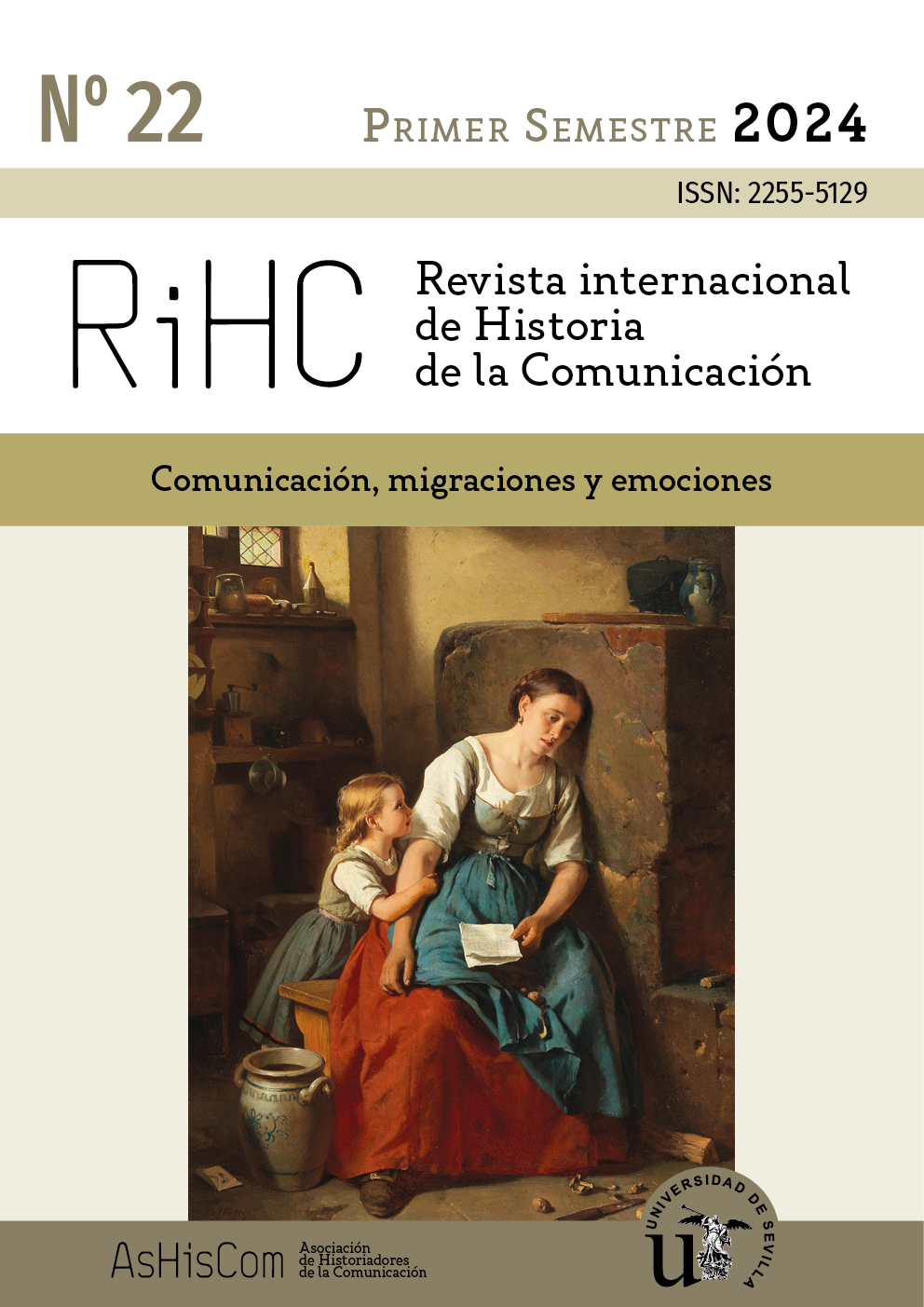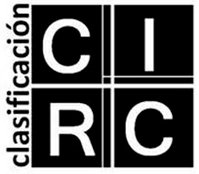"Aguardan el día en que un vapor les repatrie”: la imagen de los españoles repatriados en el diario ahora (1930-1936)
DOI:
https://doi.org/10.12795/RIHC.2024.i22.01Palabras clave:
emigración, emociones, prensa, repatriación, retornoResumen
El impacto de la recesión económica de los años treinta del siglo XX entre los emigrantes españoles en América generó una significativa diáspora de repatriados. El costo de las repatriaciones y las condiciones materiales extremadamente precarias que traían alarmaron a la administración republicana y tuvieron repercusión en los medios de comunicación. En este sentido, esta investigación se centra en estudiar la imagen de los españoles repatriados de Latinoamérica en el diario Ahora (1930-1936), analizando las emociones, acciones y representaciones asociadas a las personas de este grupo. Utilizando un enfoque cualitativo hemos realizado una revisión hemerográfica y un análisis crítico del discurso de las noticias publicadas sobre el tema en el diario Ahora. Los resultados muestran que Ahora priorizó un enfoque generalizante de los repatriados que ocultaba la diversidad interior del grupo y los relacionaba con ideas como fracaso, indigencia y pasividad. Este tipo de encuadre dificulta la creación de puentes empáticos y puede inducir al rechazo social. Se evidencia también que la cobertura de este fenómeno tuvo una función de alerta para evitar nuevas emigraciones.
Descargas
Citas
AHMED, S. (2015): La política Cultural de las emociones, México D.F., Universidad Autónoma de México.
BEDOYA, C. Y MOLINA, N. (2021): “El estudio de las emociones desde el giro afectivo a las prácticas y atmósferas afectivas”, en Revista Colombiana de Ciencias Sociales, nº12(2), pp. 928-948
BERMEJO-BEJARANO, M. C. y GONZÁLEZ-GUERRERO, I. (2021): “Rostros de la migración: construcción discursiva de sensibilidades sociales” en Ciencia Política, nº16(32), pp. 45-73.
CERASE, F. (1974): “Expectations and Reality: A Case Study of Return Migration from the United States to Southern Italy”, en The International Migration Review, nº8, pp. 245-262.
CORTINA, A. (2017): Aporofobia, el rechazo al pobre, Barcelona, Editorial Paidós
DE JUANA, J. (1982): La prensa de centro durante la II república Española: el diario Ahora. [Tesis de doctorado] Universidad Complutense de Madrid. Disponible en Internet (29-03-2024): https://docta.ucm.es/bitstreams/879f683f-dbaf-4842-8cec-add558d1333e/download
Emigración y repatriación de españoles en Iberoamérica durante la Segunda República Española (1931-1936), en Pérez, P. (coord.), Inmigración, integración e imagen de los latinoamericanos en España (1931-1987), Madrid, Organización de Estados Iberoamericanos, pp.99-136.
FERNÁNDEZ, M. (2022): “La construcción de una visión del retorno en la opinión pública española durante los años de la gran ola migratoria (1880-1930)” en Estudios de Historia de España, nº24(2), pp. 99-115.
GIL-LÁZARO, A. (2014): “Financiación y gestión de la repatriación de inmigrantes españoles entre 1907 y 1936” en Hispania, nº74(247), pp. 465-494.
- (2022): “El fin de la emigración masiva en los debates de las Cortes de la Segunda República española” en Estudios de Historia de España, nº24(2), pp. 116-136.
GONZÁLEZ-ALBO, P. (2019): “Los sefardíes en la prensa española: informaciones en el diario Ahora (1930-1939)” en MEAH. Sección Hebreo, nº68, pp.99-124.
HAMILTON, D. y SHERMAN, S. (1989): Illusory Correlations: Implications for Stereotype Theory and Research, en Bar-Tal, D. et al. (Eds.), Stereotyping and Prejudice. Changing Conceptions, Nueva York, Springer, pp.59-82.
IGARTUA, J. J., MUÑIZ, C. y CHENG, L. (2005): “La inmigración en la prensa española. Aportaciones empíricas y metodológicas desde la teoría del encuadre noticioso”, en Migraciones, nº17, pp.143-181.
IGARTUA PEROSANZ, J. J., MUÑIZ, C., CALVO DE CASTRO, P., OTERO PARRA, J. A., MERCHÁN, J. (2005a): “La imagen de la inmigración en la prensa y la televisión. Aproximaciones empíricas desde la Teoría de Framing”, en Romay Martínez J., García Mira, R. y Real Deus, J. E. (ed.), Psicología social y problemas sociales, Madrid, Biblioteca Nueva, pp.239-246.
JAGGAR, A. (1989): “Love and Knowledge: Emotion in Feminist Epistemology” en Inquiry, nº32, pp. 151-176.
LE BRETON, D. (2013): “Por una antropología de las emociones”, en Revista Latinoamericana de Estudios sobre Cuerpos, Emociones y Sociedad, Nº10(4), pp.67-77
MANJARRÉS, E. (2020): “Uso de referentes religiosos en el discurso político de Hugo Chávez” en Política y Cultura, nº54, pp.85-104.
MÉNDEZ, G. L. (2012): “Las vidas subprime: la circulación de historias de vida como tecnología de imaginación política en la crisis española (2007–2012)” en Hispanic Review, nº80(4), pp. 557–581.
NUSSBAUM, M. (2008): Paisajes del pensamiento: la inteligencia de las emociones, Barcelona, Paidós.
OLIVERA, M. (2016): “La ilustración de la guerra en el diario Ahora” en Fotocinema, nº13, pp. 87-106.
PIZARROSO, A. (2010): “El periodismo en el primer tercio del siglo XX” en Arbor, nº186, pp. 45-54.
SÁNCHEZ, B. (1995): Las causas de la emigración española, 1880-1930, Madrid, Alianza
TABANERA, N. (1999): “La política migratoria española entre la dictadura y la República (1923-1936): tutela y repatriación del emigrante español en América Latina”, en VV.AA. Exils et Migrations Ibériques au XXe siécle, París, Centre de recherches hispaniques, 73-93.
― (1988): Emigración y repatriación de españoles en Iberoamérica durante la Segunda República Española (1931-1936), en Pérez, P. (coord.), Inmigración, integración e imagen de los latinoamericanos en España (1931-1987), Madrid, Organización de Estados Iberoamericanos, pp.99-136.
VAN DIJK, T. (1994): “Discourse and cognition in society”, en: CROWLEY, D., y MITCHELL, D. (editores), Communication theory today, Cambridge, Polity Press, pp. 107-126.
VAN DIJK, T. et al. (2000): “Discurso, filiación étnica, cultural y racismo”, en VAN DIJK, T. (coomp.), El discurso como interacción social: estudios del discurso, Barcelona, Gedisa, pp. 213-262
Descargas
Publicado
Cómo citar
Número
Sección
Licencia
Derechos de autor 2024 RIHC. Revista Internacional de Historia de la Comunicación

Esta obra está bajo una licencia internacional Creative Commons Atribución-NoComercial-CompartirIgual 4.0.
RiHC. Revista internacional de Historia de la Comunicación es una publicación de acceso libre, ofrece su contenido bajo el principio de que hacer disponible gratuitamente la investigación al publico apoya a un mayor intercambio de conocimiento global.
RIHC. Revista internacional de Historia de la Comunicación se adhiere a las diferentes iniciativas que promueven el acceso libre al conocimiento, por lo que todos los contenidos son de acceso libre y gratuito y se publican bajo licencia de Creative Commons Reconocimiento-NoComercial 4.0 Internacional.

En virtud de ello, los autores que publiquen en esta revista aceptan las siguientes condiciones:
Los autores conservan los derechos de autor y ceden a la revista el derecho de la primera publicación, con el trabajo registrado con la licencia de atribución de Creative Commons, que permite a terceros utilizar lo publicado siempre que mencionen la autoría del trabajo y a la primera publicación en esta revista.
Los autores pueden realizar otros acuerdos contractuales independientes y adicionales para la distribución no exclusiva de la versión del artículo publicado en esta revista (p. ej., incluirlo en un repositorio institucional o publicarlo en un libro) siempre que indiquen claramente que el trabajo se publicó por primera vez en esta revista.
Se permite y recomienda a los autores publicar su trabajo en Internet (por ejemplo en páginas institucionales o personales) ya que puede conducir a intercambios productivos y a una mayor y más rápida difusión del trabajo publicado (vea The Effect of Open Access).
No prevé moving wall o período de embargo
Debe utilizarse la versión de editor/PDF
La fuente editorial debe reconocerse













